当前位置:网站首页>Variable star user module
Variable star user module
2022-07-06 11:52:00 【mb61037a3723f67】
Catalog
- One : Get verification code :
- Two : Register login :
- 3、 ... and : Get user information :
- Four :Tocken Refresh mechanism :
- 5、 ... and : Modify the user's Avatar :
- 5.1: Seven cattle cloud head test :
- 5.2: Seven cattle cloud is encapsulated in the project :
- 5.3: Check the picture type and packaging :
- 5.4: Modify user avatar view :
- 5.5:YApi Interface management platform :
- 6.1: Deploy the front-end files to the server :
- 6.2: Solve the cross domain problem of front and back end :
One : Get verification code :
1: Custom converter , Then register the converter :
cmmon/utils/converters.py
from werkzeug.routing import BaseConverter
# 1: Custom converters inherit from BaseConverter
class MobileConverter(BaseConverter):
"""
Mobile number format
"""
# 2: rewrite regex
regex = r'1[3-9]\d{9}'
- 1.
- 2.
- 3.
- 4.
- 5.
- 6.
- 7.
- 8.
- 9.
- 10.
app/__init__.py Medium def register_extensions in .
# Register custom converter
from utils.converters import MobileConverter
app.url_map.converters['mob'] = MobileConverter
- 1.
- 2.
- 3.
2: Use converters in views :
app/resources/user/passport.py
from flask import jsonify
from flask_restful import Resource
import random
from app import redis_cli
from utils.contants import SMS_CODE_EXPIRE
class SMSCodeResource(Resource):
"""
View of sending SMS verification code
"""
def get(self, mobile):
# 1: Get your phone number
# 2: Generate 6 Bit of SMS verification code
sms_code = "%06d" % (random.randint(0, 999999))
sms_code = 123456
# 3: Store SMS verification code in redis database
key = "app:code:{}".format(mobile)
redis_cli.setex(key, SMS_CODE_EXPIRE, sms_code)
# 4: Call a third party to send SMS verification code
print(" Sending SMS verification code succeeded : Phone number :{} SMS verification code {}".format(mobile,sms_code ))
return {"mobile": mobile, "sms_code": sms_code}
- 1.
- 2.
- 3.
- 4.
- 5.
- 6.
- 7.
- 8.
- 9.
- 10.
- 11.
- 12.
- 13.
- 14.
- 15.
- 16.
- 17.
- 18.
- 19.
- 20.
- 21.
- 22.
3: test :
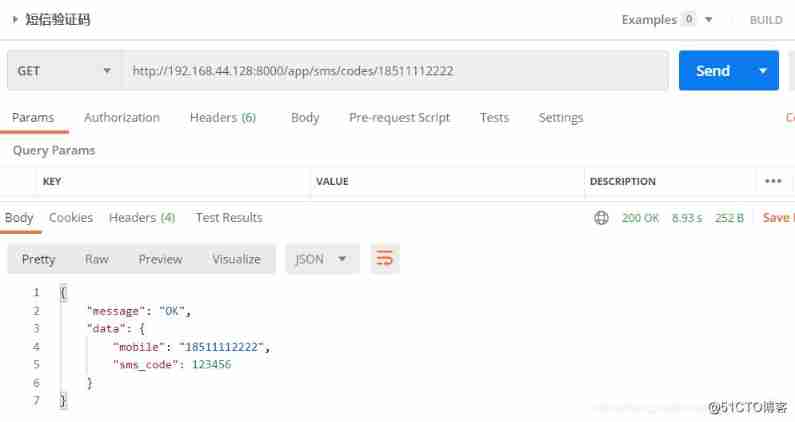
Two : Register login :
1: Configure routing information :
user/__init__.py
user_api.add_resource(LoginRegisterResource, '/authorizations')
- 1.
2: establish User User's model classes and relational tables :
common/models/user.py
from app import db
from datetime import datetime
class User(db.Model):
"""
Basic information of users
"""
__tablename__ = 'user_basic'
id = db.Column(db.Integer, primary_key=True, doc=' user ID')
mobile = db.Column(db.String(11), doc=' cell-phone number ')
name = db.Column(db.String(20), doc=' nickname ')
last_login = db.Column(db.DateTime, doc=' Last login time ')
introduction = db.Column(db.String(50), doc=' brief introduction ')
article_count = db.Column(db.Integer, default=0, doc=' Number of works ')
following_count = db.Column(db.Integer, default=0, doc=' Number of people concerned ')
fans_count = db.Column(db.Integer, default=0, doc=' Number of fans ')
profile_photo = db.Column(db.String(130), doc=' Head portrait ')
def to_dict(self):
""" Model to dictionary , For serialization processing """
return {
'id': self.id,
'name': self.name,
'photo': self.profile_photo,
# Be careful :redis I won't support it None type But it supports empty strings
'intro': self.introduction if self.introduction else "",
'art_count': self.article_count,
'follow_count': self.following_count,
'fans_count': self.fans_count
}
class Relation(db.Model):
"""
User relationship table
"""
__tablename__ = 'user_relation'
class RELATION:
# Cancel the attention
DELETE = 0
# Focus on
FOLLOW = 1
# Pull black
BLACKLIST = 2
id = db.Column(db.Integer, primary_key=True, doc=' Primary key ID')
user_id = db.Column(db.Integer, doc=' user ID') # fans id
author_id = db.Column(db.Integer, doc=' Target users ID') # author id
relation = db.Column(db.Integer, doc=' Relationship ')
update_time = db.Column(db.DateTime, default=datetime.now, doc=' Update time ')
- 1.
- 2.
- 3.
- 4.
- 5.
- 6.
- 7.
- 8.
- 9.
- 10.
- 11.
- 12.
- 13.
- 14.
- 15.
- 16.
- 17.
- 18.
- 19.
- 20.
- 21.
- 22.
- 23.
- 24.
- 25.
- 26.
- 27.
- 28.
- 29.
- 30.
- 31.
- 32.
- 33.
- 34.
- 35.
- 36.
- 37.
- 38.
- 39.
- 40.
- 41.
- 42.
- 43.
- 44.
- 45.
- 46.
- 47.
- 48.
- 49.
- 50.
- 51.
- 52.
- 53.
- 54.
app/__init__.py
from flask_migrate import Migrate
def register_extensions(app:Flask):
...
# 4: Perform database migration
Migrate(app, db)
# Note that the guide package is needed here
from models.user import User
- 1.
- 2.
- 3.
- 4.
- 5.
- 6.
- 7.
Execute the migration command :
1: Migration command
export FLASK_APP = app.main
SET FLASK_APP = app.main(windows)
2: Migration initialization
flask db init
3: Build migration version
flask db migrate
4: Upgrade the migration version
flask db upgrade
Recover database data :
1: take sql File move to utils It's a bag .
2: Execute the command after remote login :

3: stay utils Created in jwt_utils.py:
import jwt
from flask import current_app
def generate_jwt(payload, expiry, secret=None):
"""
Generate jwt
:param payload: dict load
:param expiry: datetime The period of validity
:param secret: secret key
:return: jwt
"""
_payload = {'exp': expiry}
_payload.update(payload)
if not secret:
secret = current_app.config['JWT_SECRET']
token = jwt.encode(_payload, secret, algorithm='HS256')
return token.decode()
def verify_jwt(token, secret=None):
"""
test jwt
:param token: jwt
:param secret: secret key
:return: dict: payload
"""
if not secret:
secret = current_app.config['JWT_SECRET']
try:
payload = jwt.decode(token, secret, algorithm=['HS256'])
except jwt.PyJWTError:
payload = None
return payload
- 1.
- 2.
- 3.
- 4.
- 5.
- 6.
- 7.
- 8.
- 9.
- 10.
- 11.
- 12.
- 13.
- 14.
- 15.
- 16.
- 17.
- 18.
- 19.
- 20.
- 21.
- 22.
- 23.
- 24.
- 25.
- 26.
- 27.
- 28.
- 29.
- 30.
- 31.
- 32.
- 33.
- 34.
- 35.
- 36.
- 37.
- 38.
4: stay app/settings/config.py add JWT Configuration information :
class BaseConfig(object):
...
# JWT Configuration information
# JWT secret key
JWT_SECRET = "adadwAdmldadnawasdadwddnodam"
# 2 Hours of tocken Expiration time
LOGIN_TOCKEN_EXPIRE = 2
# 14 Refresh of days tockend The expiration time of
REFRESH_TOCKEN_EXPIRE = 14
- 1.
- 2.
- 3.
- 4.
- 5.
- 6.
- 7.
- 8.
- 9.
5: Construct to generate two tocken Function of :
class LoginRegisterResource(Resource):
def _generator_tocken(self, user_id):
"""
Internally generated tocken Methods
:param user_id: The current user is logged in
:return:
"""
login_payload = {
"user_id": user_id,
"is_refresh": False
}
expire_2h = datetime.datetime.utcnow() + datetime.timedelta(hours=current_app.config["LOGIN_TOCKEN_EXPIRE"])
jwt_secret = current_app.config['JWT_SECRET']
login_tocken = generate_jwt(payload=login_payload, expiry=expire_2h, secret=jwt_secret)
refresh_payload = {
"user_id": user_id,
"is_refresh": True
}
expire_14d = datetime.datetime.utcnow() + datetime.timedelta(days=current_app.config["LOGIN_TOCKEN_EXPIRE"])
refresh_tocken = generate_jwt(payload=refresh_payload, expiry=expire_14d, secret=jwt_secret)
return login_tocken, refresh_tocken
- 1.
- 2.
- 3.
- 4.
- 5.
- 6.
- 7.
- 8.
- 9.
- 10.
- 11.
- 12.
- 13.
- 14.
- 15.
- 16.
- 17.
- 18.
- 19.
- 20.
- 21.
- 22.
- 23.
- 24.
- 25.
6: Login registration logic :
Logic of login and registration interface :
1: To obtain parameters
1.1: mobile cell-phone number
1.2:code SMS verification code filled in by the user
2: Test parameters —RequestParser
3: Logical processing
3.1: According to the mobile phone number in reis Query the real verification code in the database
3.2: Delete redis Verification code in the database
3.3: Judge whether the SMS verification code sent by the user is empty , And whether it is with redis The results found in are consistent .
3.4: Query in the database according to the mobile phone number User Whether there is
3.5: Users exist – Sign in
3.6: The user doesn't exist — register
3.7: Generate login tocken And refresh tocken
4: Build response returns
# Return to login tocken And refresh tocken.
class LoginRegisterResource(Resource):
def _generator_tocken(self, user_id):
...
def post(self):
# Calibration parameters
parser = RequestParser()
parser.add_argument("mobile", required=True, location="json", type=regex(r'^1[3-9]\d{9}$'))
parser.add_argument("code", required=True, location="json", type=regex(r'^\d{6}$'))
ret = parser.parse_args()
# Get the verified mobile number and SMS verification code
mobile = ret['mobile']
code = ret['code']
# According to the mobile phone number redis The real SMS verification code of the database
key = "app:code:{}".format(mobile)
real_code = redis_cli.get(key)
# Delete redis SMS verification code in
redis_cli.delete(key)
# Judge whether the SMS verification code is empty
# Notice the creation of redis Specify response decoding when data
if real_code is None or code != real_code:
return {"message": "invalid sms code"}, 400
# Get user object
user = User.query.options(load_only(User.id)).filter(User.mobile == mobile).first()
# If the user doesn't exist , A new user
if user is None:
user = User(mobile= mobile, name=mobile, last_login=datetime.datetime.now())
db.session.add(user)
else:
# If the user exists , Modify the login time of the user
user.last_login = datetime.datetime.now()
db.session.add(user)
# Try to submit , If not, roll back .
try:
db.session.commit()
except Exception as e:
db.session.rollback()
return {"messgae": e}, 507
login_tocken, refresh_tocken = self._generator_tocken(user.id)
return {
"login_tocken": login_tocken,
"refresh_tocken": refresh_tocken
}
- 1.
- 2.
- 3.
- 4.
- 5.
- 6.
- 7.
- 8.
- 9.
- 10.
- 11.
- 12.
- 13.
- 14.
- 15.
- 16.
- 17.
- 18.
- 19.
- 20.
- 21.
- 22.
- 23.
- 24.
- 25.
- 26.
- 27.
- 28.
- 29.
- 30.
- 31.
- 32.
- 33.
- 34.
- 35.
- 36.
- 37.
- 38.
- 39.
- 40.
- 41.
- 42.
- 43.
- 44.
- 45.
- 46.
- 47.
7: test :
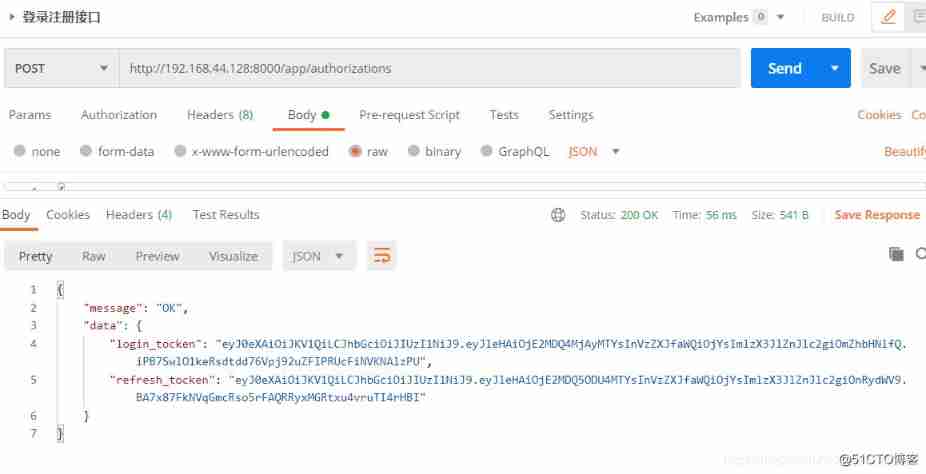
3、 ... and : Get user information :
1:utils/middleware Create a decorator to get user information , Then take the initiative to decorate .
from flask import request, current_app, g
from utils.jwt_util import verify_jwt
# Access to user information
def get_userinfo():
# 1: Get the tocken Information
# The front end is required to pass Authorialization Fields carry tocken
tocken = request.headers.get("Authorization")
# 2: Conduct tocken test , The load may be empty
# tocken error , Or expired
key = current_app.config["JWT_SECRET"]
payload = verify_jwt(tocken, key)
if payload:
# Extract user information from the load
g.user_id = payload.get("user_id")
g.is_refresh = payload.get("is_refresh", False)
else:
g.user_id = None
g.is_refresh = None
- 1.
- 2.
- 3.
- 4.
- 5.
- 6.
- 7.
- 8.
- 9.
- 10.
- 11.
- 12.
- 13.
- 14.
- 15.
- 16.
- 17.
- 18.
- 19.
- 20.
- 21.
2: stay app/__init__.py The decorator is actively decorated :
def register_extensions(app:Flask):
...
# 5: Add request hook
from utils.middleware import get_userinfo
app.before_request(get_userinfo)
- 1.
- 2.
- 3.
- 4.
- 5.
3: Create decorators that force users to log in :
utils/decoratores.py
from flask import g
# Force users to log in
def login_required(view_func):
def wrapper(*args, **kwargs):
user_id = g.user_id
is_refresh = g.is_refresh
if user_id is None:
return {"message": "invalid tocken"}, 401
elif user_id is not None and is_refresh:
return {"message": "refresh tocken not for login"}, 403
else:
return view_func(*args, **kwargs)
return wrapper
- 1.
- 2.
- 3.
- 4.
- 5.
- 6.
- 7.
- 8.
- 9.
- 10.
- 11.
- 12.
- 13.
- 14.
- 15.
4: Chinese coding problem :
app/settings/config.py
# Configure the parent class
class BaseConfig(object):
...
# Chinese coding problem :
LOGIN_AS_ASCII = False
RESTFUL_JSON = {"ensure_ascii": False}
- 1.
- 2.
- 3.
- 4.
- 5.
- 6.
5: Get user information view :
app/resource/user/passport.py
# Get current login user information
class CurrentUserResource(Resource):
method_decorators = {
"get": [login_required]
}
def get(self):
# 1: To obtain parameters
user_id = g.user_id
# 2; according to user_id Query user information
user = User.query.options(load_only(User.id,
User.name,
User.profile_photo,
User.introduction,
User.article_count,
User.following_count,
User.fans_count)).filter(User.id == user_id).first()
# 3: Convert the user object into a dictionary and return
user_dict = user.to_dict()
return user_dict
- 1.
- 2.
- 3.
- 4.
- 5.
- 6.
- 7.
- 8.
- 9.
- 10.
- 11.
- 12.
- 13.
- 14.
- 15.
- 16.
- 17.
- 18.
- 19.
- 20.
- 21.
- 22.
6: Add route :
app/resource/user/__init__.py
user_api.add_resource(CurrentUserResource, '/user')
- 1.
7: To test :
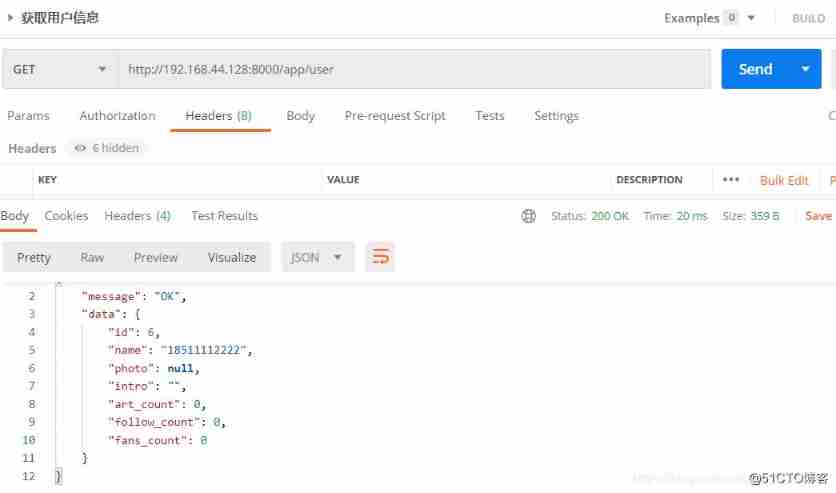
Four :Tocken Refresh mechanism :
1:app/resources/user/passport.py
class LoginRegisterResource(Resource):
def _generator_tocken(self, user_id):
...
def post(self):
...
def put(self):
# 1: obtain user_id
user_id = g.user_id
# 2: Get refresh tocken Sign a
is_refresh = g.is_refresh
# 3 Determine whether to refresh tocken
if user_id and is_refresh:
login_tocken, is_refresh_tocken = self._generator_tocken(user_id)
return {"new_tocken": login_tocken, "new_login_tocken": is_refresh_tocken}
else:
return {"message": "wrong refresh tocken"}, 403
- 1.
- 2.
- 3.
- 4.
- 5.
- 6.
- 7.
- 8.
- 9.
- 10.
- 11.
- 12.
- 13.
- 14.
- 15.
- 16.
- 17.
2: test :
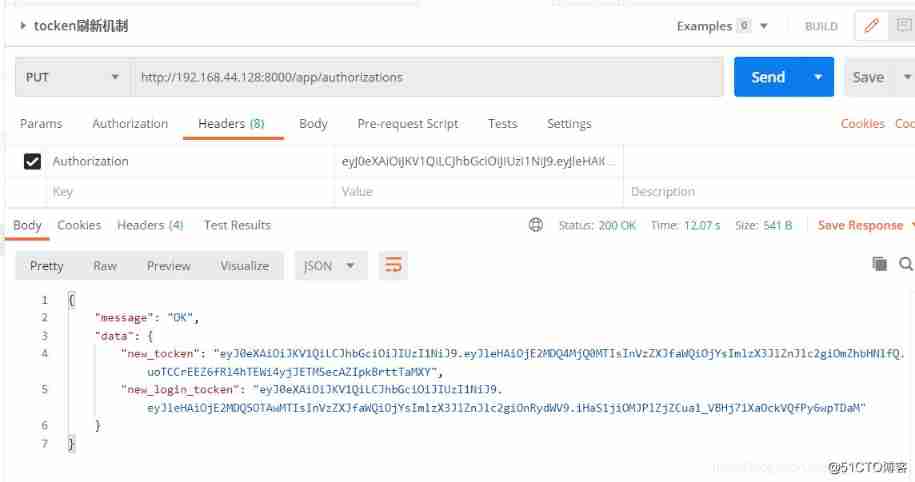
5、 ... and : Modify the user's Avatar :
5.1: Seven cattle cloud head test :
1: Seven cattle cloud test case :
from qiniu import Auth, put_file, etag, put_data
import qiniu.config
def upload_pic(data):
# 1: You need to fill in your Access Key and Secret Key
access_key = 'LSo9n249hhQP9VQPHtJkNpC-2l6zAAJUgYm0q69J'
secret_key = 'lnm0ebW2Qp3CLZberagsKPfBY2p_aDo_IV-_LP-J'
# 2: Build authentication object
q = Auth(access_key, secret_key)
# 3: Space to upload
bucket_name = 'sztopnews'
# File name saved after upload , The picture name is empty , According to the picture data , Generate a unique picture name by hashing
key = None
# 4: Generate upload Token, You can specify expiration time, etc
# pit centos The time may expire , To refresh centos Time for
token = q.upload_token(bucket_name, key, 360000000)
# 5: Upload binary file data
ret, info = put_data(token, key, data)
# 6: Judge whether the upload is successful
# if info.status_code == 200:
# return ret['key']
# else:
# # Throw an exception
# raise info.exception
print(ret)
print("**"*10)
print(info)
if __name__ == '__main__':
with open("./1.png", 'rb') as f:
upload_pic(f.read())
- 1.
- 2.
- 3.
- 4.
- 5.
- 6.
- 7.
- 8.
- 9.
- 10.
- 11.
- 12.
- 13.
- 14.
- 15.
- 16.
- 17.
- 18.
- 19.
- 20.
- 21.
- 22.
- 23.
- 24.
- 25.
- 26.
- 27.
- 28.
- 29.
- 30.
- 31.
- 32.
- 33.
- 34.
- 35.
- 36.
- 37.
- 38.
- 39.
2: Test run results :

5.2: Seven cattle cloud is encapsulated in the project :
1: stay app/settings/config.py Add the configuration information of qiniu cloud :
# Configure the parent class
class BaseConfig(object):
...
# Configuration information of qiniu cloud
QINIU_ACCESS_KEY = 'LSo9n249hhQP9VQPHtJkNpC-2l6zAAJUgYm0q69J'
QINIU_SECRET_KEY = 'lnm0ebW2Qp3CLZberagsKPfBY2p_aDo_IV-_LP-J'
QINIU_BUCKET_NAME = 'sztopnews'
QINIU_DOMAIN = 'http://qji837cfs.hn-bkt.clouddn.com/'
- 1.
- 2.
- 3.
- 4.
- 5.
- 6.
- 7.
- 8.
2: Create in the toolkit image_storage.py:
from qiniu import Auth, put_file, etag, put_data
from flask import current_app
import qiniu.config
def upload_pic(data):
# 1: You need to fill in your Access Key and Secret Key
access_key = current_app.config['QINIU_ACCESS_KEY']
secret_key = current_app.config['QINIU_SECRET_KEY']
# 2: Build authentication object
q = Auth(access_key, secret_key)
# 3: Space to upload
bucket_name = current_app.config['QINIU_BUCKET_NAME']
# File name saved after upload , The picture name is empty , According to the picture data , Generate a unique picture name by hashing
key = None
# 4: Generate upload Token, You can specify expiration time, etc
# pit centos The time may expire , To refresh centos Time for
token = q.upload_token(bucket_name, key, 360000000)
# 5: Upload binary file data
ret, info = put_data(token, key, data)
# 6: Judge whether the upload is successful
if info.status_code == 200:
return ret['key']
else:
# Throw an exception
raise BaseException(info.exception)
- 1.
- 2.
- 3.
- 4.
- 5.
- 6.
- 7.
- 8.
- 9.
- 10.
- 11.
- 12.
- 13.
- 14.
- 15.
- 16.
- 17.
- 18.
- 19.
- 20.
- 21.
- 22.
- 23.
- 24.
- 25.
- 26.
- 27.
- 28.
- 29.
- 30.
- 31.
5.3: Check the picture type and packaging :
1: First test in the test file : There are two schemes, one is to pass in the object , An incoming picture data .
import imghdr
with open("./1.png", "rb") as f:
# Scheme 1
# Check the type of file
type = imghdr.what(f)
print(type)
# Option two :
type2 = imghdr.what(None, f.read())
print(type2)
- 1.
- 2.
- 3.
- 4.
- 5.
- 6.
- 7.
- 8.
- 9.
2: Encapsulate the function of checking the image type into the tool class :
def img_type(value):
"""
Check whether it is a picture type
:param value:
:return:
"""
try:
type = imghdr.what(value)
except Exception as e:
raise ValueError(e)
if type:
return value
else:
raise ValueError("invalid image type")
- 1.
- 2.
- 3.
- 4.
- 5.
- 6.
- 7.
- 8.
- 9.
- 10.
- 11.
- 12.
- 13.
- 14.
5.4: Modify user avatar view :
1:app/user/profile/py Create a view in :
from flask_restful import Resource
from flask import g
from app import db
from models.user import User
from utils.decoratores import login_required
from flask_restful.reqparse import RequestParser
from flask import current_app
from utils.img_storage import upload_pic
from utils.parser import img_type
class UserPhotoResource(Resource):
"""
Modify the view of user avatar
"""
method_decorators = {
"patch": [login_required]
}
def patch(self):
# 1: To obtain parameters
user_id = g.user_id
# 2: Test parameters
parser = RequestParser()
parser.add_argument("photo", required=True, location="files", type=img_type)
ret = parser.parse_args()
# 3: Get the inspected image object
photo_file = ret['photo']
# 4: Convert pictures into binary data
photo_bytes = photo_file.read()
# 5: Call the tool class and upload it to qiniu cloud
try:
img_name = upload_pic(photo_bytes)
except Exception as e:
return {"message": "Third Error : {}".format(e)}, 500
# TODO : Store the picture name or store it completely URL The path ?
# The name of the stored picture is good , It is convenient to modify the domain name in the future
# 6: Splice the complete picture url Address
full_url = current_app.config["QINIU_DOMAIN"] + img_name
# 7: Query the user , Update user profile
User.query.filter(User.id == user_id).update({"profile_photo": full_url})
try:
db.session.commit()
except Exception as e:
return {"message": e}, 507
return {"photo_url": full_url}
- 1.
- 2.
- 3.
- 4.
- 5.
- 6.
- 7.
- 8.
- 9.
- 10.
- 11.
- 12.
- 13.
- 14.
- 15.
- 16.
- 17.
- 18.
- 19.
- 20.
- 21.
- 22.
- 23.
- 24.
- 25.
- 26.
- 27.
- 28.
- 29.
- 30.
- 31.
- 32.
- 33.
- 34.
- 35.
- 36.
- 37.
- 38.
- 39.
- 40.
- 41.
- 42.
- 43.
- 44.
- 45.
- 46.
- 47.
- 48.
- 49.
- 50.
- 51.
2: Add route user/__init__.py
user_api.add_resource(UserPhotoResource, '/user/photo')
- 1.
3: test : Both the database and the response exist .
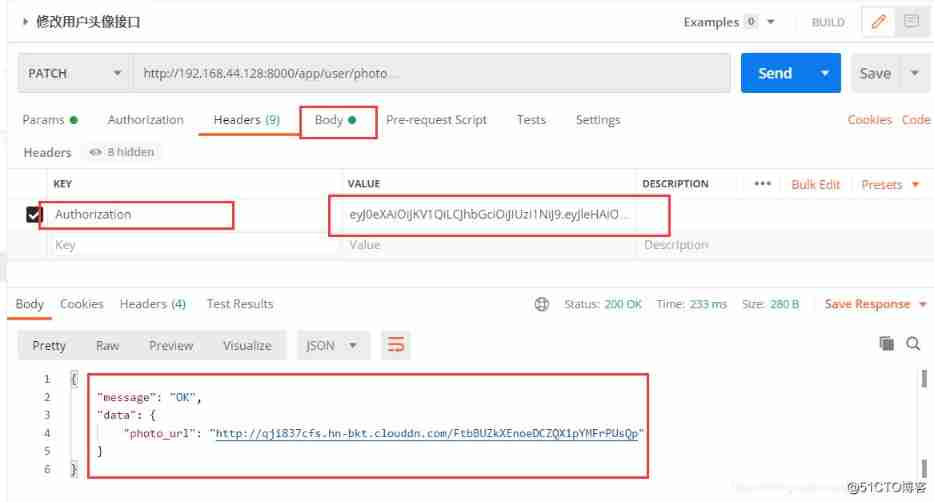

5.5:YApi Interface management platform :
1:YApi The experience area of :
2:YApi Official documents of :
hellosean1025.github.io/yapi
6、 ... and : View front end interactions :
6.1: Deploy the front-end files to the server :
1: Decompress the front-end package locally :
2: Upload the file to the server :
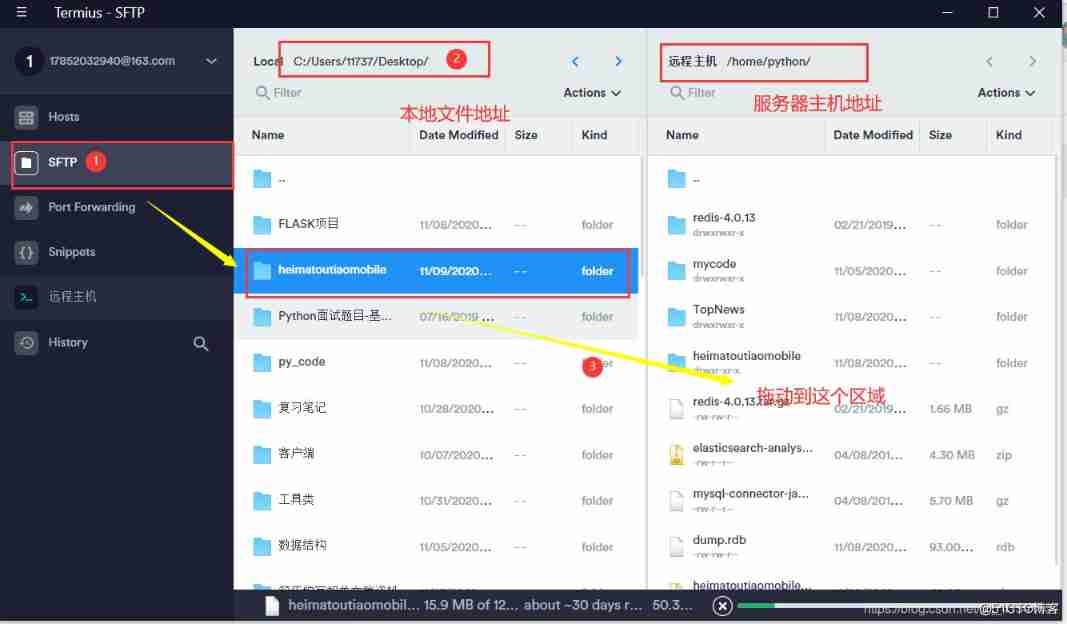
3: Enter the virtual environment , Then start the front-end file :

6.2: Solve the cross domain problem of front and back end :
1: install flask_cors:
pip install flask-cors
2: To solve the cross domain :
app/__init__.py
from flask_cors import CORS
def register_extensions(app:Flask):
...
# 6: Add cross domain request
# app: Allow cross domain app object ,
# supports_credentials= True, It is carried when supporting cross domain cookie and session,tocken authentication
# methods = [], Allow cross domain requests . All are allowed by default .
CORS(app, supports_credentials=True)
- 1.
- 2.
- 3.
- 4.
- 5.
- 6.
- 7.
- 8.
边栏推荐
猜你喜欢
随机推荐
Are you monitored by the company for sending resumes and logging in to job search websites? Deeply convinced that the product of "behavior awareness system ba" has not been retrieved on the official w
error C4996: ‘strcpy‘: This function or variable may be unsafe. Consider using strcpy_ s instead
误删Path变量解决
[Bluebridge cup 2021 preliminary] weight weighing
[BSidesCF_2020]Had_a_bad_day
Nodejs connect mysql
PHP - whether the setting error displays -php xxx When PHP executes, there is no code exception prompt
Codeforces Round #771 (Div. 2)
Composition des mots (sous - total)
[Kerberos] deeply understand the Kerberos ticket life cycle
常用正则表达式整理
【CDH】CDH/CDP 环境修改 cloudera manager默认端口7180
Vert. x: A simple TCP client and server demo
[CDH] modify the default port 7180 of cloudera manager in cdh/cdp environment
DICOM: Overview
Word排版(小计)
Principle and implementation of MySQL master-slave replication
FTP file upload file implementation, regularly scan folders to upload files in the specified format to the server, C language to realize FTP file upload details and code case implementation
Pytoch Foundation
vs2019 第一个MFC应用程序
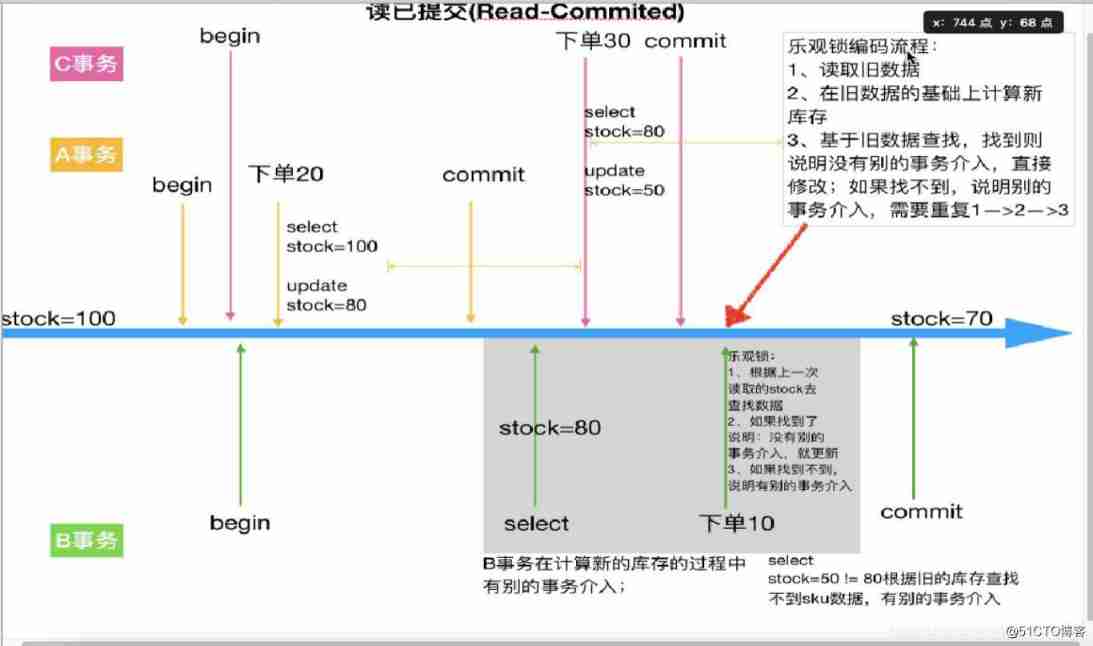
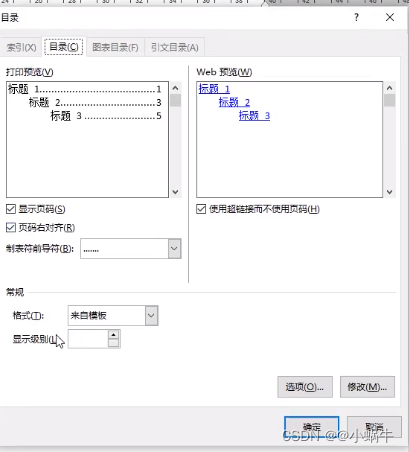
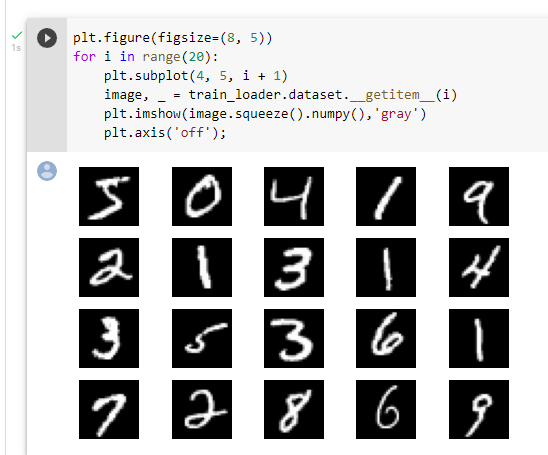
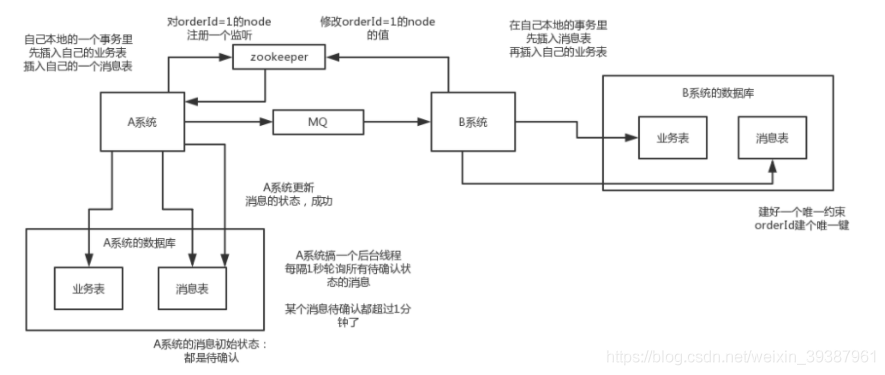
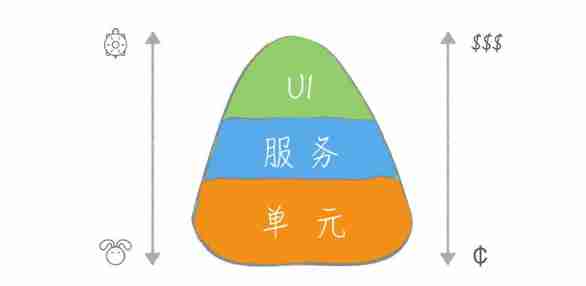

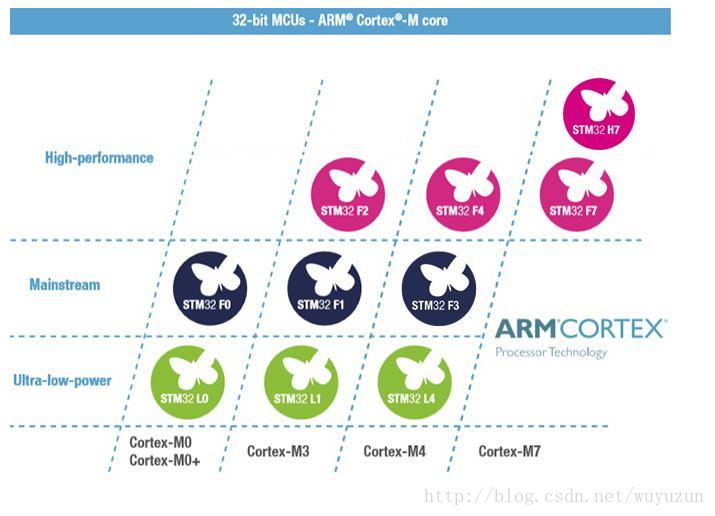
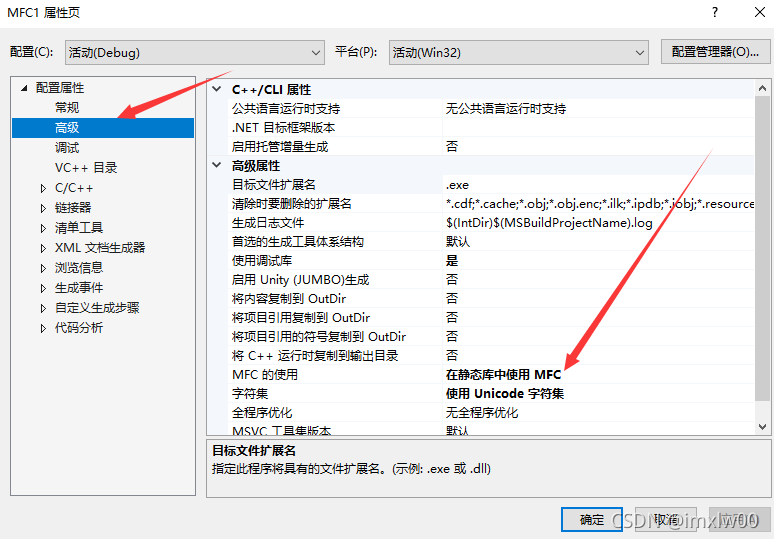
![[Flink] Flink learning](/img/2e/ff53e0795456e301f61da908c013af.png)